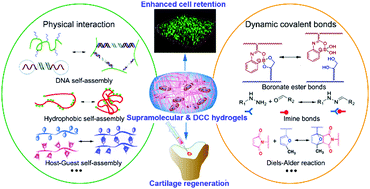Supramolecular and dynamic covalent hydrogel scaffolds: from gelation chemistry to enhanced cell retention and cartilage regeneration
Abstract
Supramolecular and dynamic covalent crosslinking (DCC) hydrogels not only display unique physicochemical properties that can mimic the dynamic extracellular matrix (ECM), but also have the capabilities of shear-thinning, self-healing and even shape memorizing. Specifically, through the breaking and reforming of the reversible linkage, cells can be readily encapsulated in the matrix and can well maintain their differentiation potentials. The dynamic shear-thinning and self-healing hydrogels can also be explored as cell-compatible bio-inks for the design of complex multicellular structures. These distinctive properties of dynamic hydrogels have attracted increasing interests in cell retention as well as cartilage tissue engineering. The biophysical and biochemical cues of hydrogel matrices have significant effects on cell fate. The studies on the relationship of cell response and the critical properties of hydrogels, such as mechanical strength, elasticity, ligand chemistry and degradation, are helpful in advancing dynamic hydrogels for cell retention and delivery. In this review, we highlight the most recent progress in the gelation strategies of biomedical supramolecular and DCC hydrogels and then focus on their applications for enhancing cell retention and cartilage/osteochondral regeneration. Furthermore, the challenges and future perspectives of supramolecular and DCC hydrogels in cell retention and cartilage regeneration are also discussed.

- This article is part of the themed collection: Recent Review Articles


 Please wait while we load your content...
Please wait while we load your content...